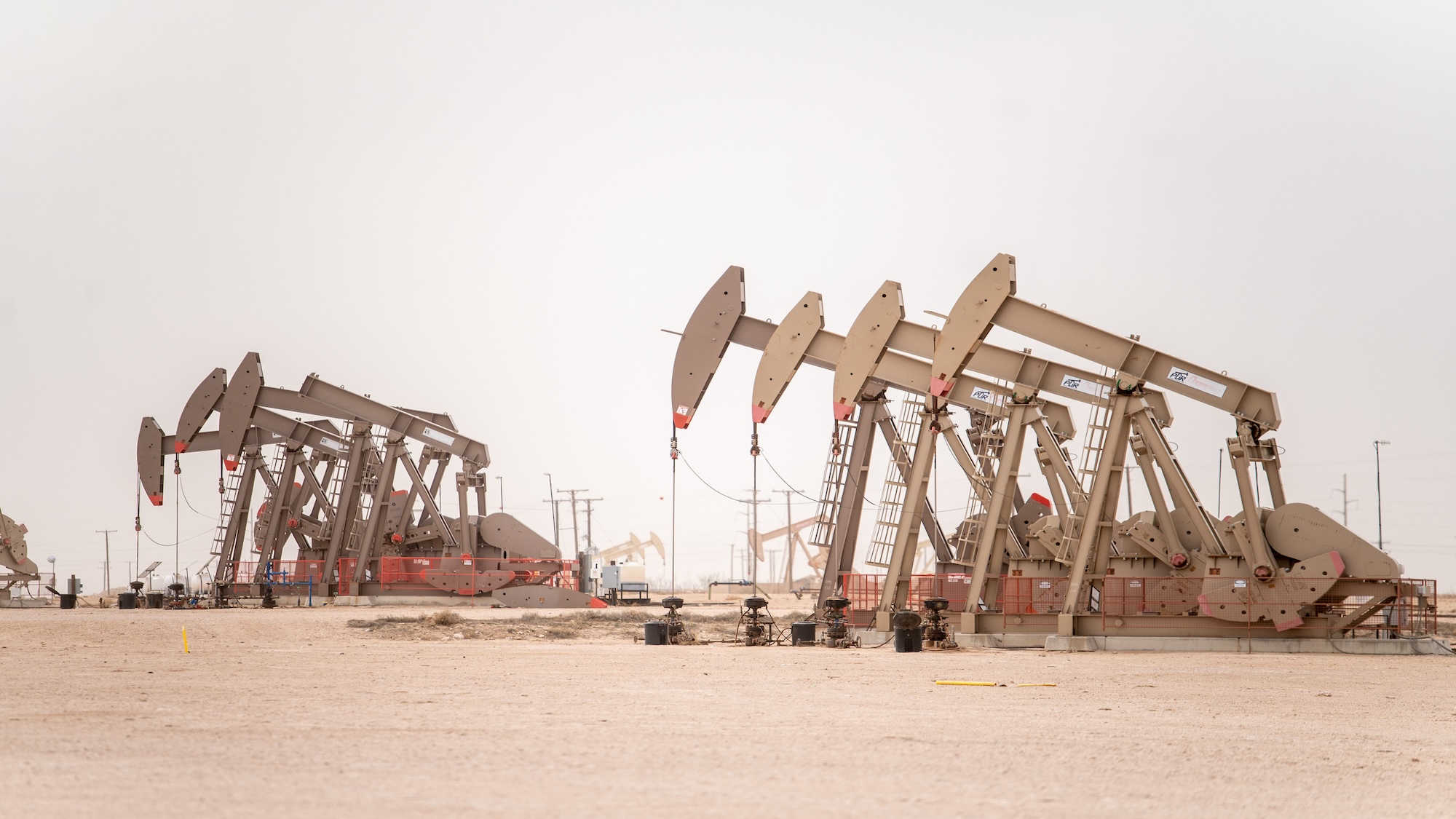Oil price posts two-year highs - but how long can it last?
Brent rose above $59 a barrel this week, its best third-quarter showing since 2004

Oil price: why it is so volatile amid Middle East tension
4 January
The oil price remains stubbornly weak, but renewed tensions in the Middle East have prompted intense volatility and, eventually, a steady rally through this afternoon.
Gains were later pared and Brent crude, which determines prices paid around the world including for oil exported from the North Sea, was up just 0.4 per cent to $37.40 a barrel this morning. But this again turned as the day wore on and by late afternoon in London Brent was up 3.9 per cent at $38.70.
The Week
Escape your echo chamber. Get the facts behind the news, plus analysis from multiple perspectives.

Sign up for The Week's Free Newsletters
From our morning news briefing to a weekly Good News Newsletter, get the best of The Week delivered directly to your inbox.
From our morning news briefing to a weekly Good News Newsletter, get the best of The Week delivered directly to your inbox.
The initial rise had been prompted, says CNBC, by the latest flare up between Saudi Arabia and Iran. Following the execution of a senior Shiite Muslim cleric in Sunni-controlled Saudi Arabia, angry Iranians attacked the Saudi embassy in Tehran. This prompted the Saudi government to announce it was severing ties with its rival, with which it has been engaged in a range of proxy conflicts of late across the region.
Both are major oil producers within the Opec cartel – Saudi Arabia is the de facto leader of the bloc with output of 10 million barrels a day, while Iran produces around three million barrels a day and this could rise by as much as one million barrels once international sanctions are lifted this year. At a time of severe oversupply, any potential hit to production levels will result in oil prices surging.
Bernstein's senior oil and gas analyst Neil Beveridge said that as much of the Saudi oil that is produced in its eastern province, which is dominated by Shiite Muslims, any substantial unrest could hit output. Gao Jian, an energy analyst at Guangzhou, China-based SCI International, added in MarketWatch that escalation of the violence could increase the chances of a delay in Iranian sanctions being lifted.
And violence did increase in Saudi Arabia at least throughout the day in its eastern province. There was wider regional fallout too, as fellow sunni states Bahrain and Sudan also cut ties with Iran, the Financial Times notes.
A free daily email with the biggest news stories of the day – and the best features from TheWeek.com
But sizeable price rises were not sustained at first - and the oil price remains at unprofitable low levels overall - because there is concern the fallout from the unrest could exacerbate an ongoing issue of excess supply.
According to Vyanne Lai, an analyst at National Australia Bank, the heightened tensions could widen the policy rift in Opec, which has prevented supply being tempered in response to falling prices. In fact, IG market strategist Evans Lucas warned the two countries may even increase output further to take market share and revenue from one other.
In a sign of how low prices are feeding through to consumer prices, the Daily Telegraph reports the big four supermarkets in the UK are set to charge less than £1 a litre for diesel for the first time since May 2009. Petrol has been at less than £1 a litre at the supermarkets since mid-December.
Oil price in pre-holiday rally, but gains will be limited
24 December
The oil price is staging a pre-Christmas rally, on the back of better-than-expected inventory data and a broadly bullish report from the Opec producer cartel.
International benchmark Brent crude had fallen to below $36 a barrel on Tuesday, the third consecutive session it had hit a new 11-year low. Yesterday afternoon it began to lift and rose to around $36.50, before the latest data from the US energy watchdog gave the upwards move an added push.
The data from the Energy Information Administration showed US stockpiles fell by around 5.8 million barrels last year, notes Reuters, far better than the 1.1 million rise expected, which helped ease concerns about oversupply. Brent contracts were changing hands for $37.70 this morning.
This week marked the first in five years the US benchmark has reached parity with Brent, after a 40-year-old ban on exports by US producers was lifted in Washington. West Texas Intermediate was trading slightly higher this morning, at around $37.80.
An initial bounce in both prices yesterday had followed the publication of a new report from the 13-nation Opec group. The paper pointed to higher overall demand in the coming five years, says the BBC, and predicted that the oil price would recover to $70 a barrel over that time, including a modest move higher in 2016. This defies some recent ultra-bearish forecasts for next year.
But gains have still been somewhat limited - Brent is, after all, still less than $2 above its recent low point and at an unprofitable level for much production. In part this is to do with low trading volumes in the lead up to Christmas, with the rally being more a function of the few traders left covering earlier bets on lower prices.
It is also, however, a reflection of some of the detail of the Opec report. In a market that remains massively overstocked the group predicted reduced demand for its products, mostly because of continued resilience from rivals despite the price slump.
Opec's prediction that there will not be any serious production declines - with Iran set to ramp up activity next year - could be taken as a bad sign as there is little to suggest that the market will properly rebalance in the near future.
Oil price: does benchmark parity mark a turning point?
23 December
The latest in a long line of significant twists in the oil price saga took place yesterday when the US benchmark briefly traded higher than its international counterpart.
The Financial Times notes that West Texas Intermediate (WTI), the benchmark price for light, sweet crude oil produced in America, has traded at a significant discount to its international equivalent Brent since around 2010 when a shale oil boom flooded the domestic market. A 40-year-old ban on exporting oil had stopped US producers competing globally and at one time meant WTI contracts were $20 cheaper than the average price for oil produced elsewhere.
This has boosted WTI relative to Brent in the past few sessions. In fact, it was marginally more expensive during Tuesday session in New York. This morning both were changing hands at around $36.50 a barrel.
Some experts claim the price switch could be the beginning of an oil price recovery on the basis that it in part reflects the slowdown in US oil output slowing. It could even mark the start of the global supply glut being reversed. "That's the first sign of rebalancing in my mind," Francisco Blanch, head of commodity research at Bank of America Merrill Lynch, told the Wall Street Journal.
Others, however, say the move is significant in itself but is unlikely to presage a wider price turnaround. "It's not like WTI moved up to meet Brent," notes Todd Gross, chief investment officer at QERI LLC. "Brent came down to WTI."
Brent fell to a new 11-year low below $36 a barrel yesterday before recovering slightly again. When Iranian exports are ramped up next year, many analysts, including as of yesterday the International Monetary Fund (see below), reckon global prices will fall sharply again and could even hit $20 a barrel. WTI is itself still languishing near seven-year lows.
While the price parity does show that the production slowdown in the US is having some effect on the market most agree it will have to be met by similar cuts from the bigger oil producers before it can have a meaningful impact on the oversupplied global market.
Oil price: IMF sees fall to between $30 and $20
22 December
Another major global forecast has suggested that the oil price has a lot further to fall yet – and that it could go as low as $20 a barrel.
This is the extreme low "cost price" predicted since the autumn by Goldman Sachs for early next year. Now the International Monetary Fund has hinted that global prices could fall this low when Iran increases its oil exports in the wake of the lifting of international sanctions.
Given prices are currently in the mid-$30s per barrel, this implies a fall back to the early 2000s level of around or below $30, or as low as $20. At this price it's likely there will be a sharp decrease in investment and production that should see a sustained – and perhaps rapid – recovery.
The news comes after oil hit another 11-year low for the second consecutive trading session yesterday. International benchmark Brent crude fell to just a few cents above $36 a barrel, but Reuters says the rolling over of monthly futures contracts has prompted a modest recovery to around $36.60 a barrel this morning.
US benchmark West Texas Intermediate is now trading only marginally lower than Brent since the recent budget deal in the US lifted an export ban, with the price around $36 a barrel this morning.
As for the consequences of falling oil prices, the International Monetary Fund says it reckons the slump would mean a 0.3 per cent boost to the global economy next year. This would be the net effect of higher consumer spending as a result of fuel and energy bills falling, minus the drag of job losses and reduced investment.
On the downside, the Los Angeles Times's Steve Yetiv says that the low oil prices worldwide are undermining arguments made at the Paris climate change summit this month that "burning fossil fuels is an increasingly costly habit". If prices remain low for too long, he says, it "will hurt efforts to address climate change, especially in the US, where citizens largely oppose raising oil taxes".
Oil price: no relief in sight as crude hits 11-year low
21 December
The oil price has plumbed new post-crisis depths, with the international benchmark hitting its lowest level since 2004 in Asian trading overnight.
While a fall to those extreme lows is unlikely, oil is expected to drop back to its early 2004 levels of $30 a barrel or less next year before it recovers in a meaningful way. Some experts even predict it will drop as low as $20 a barrel (see below).
Four factors that are fuelling this down trend – all in one way or another related to the persistent global supply glut – are being cited as reasons for the latest dip.
Top of the list of concerns is excess production. With oil having fallen by 70 per cent in the past year, global production was expected to fall as a ferocious turf war claimed swathes of victims, notably in the expensive American shale oil industry. But the sector's unexpected resilience was underlined when the US energy watchdog revealed an increase of 17 in the number of active rigs drilling for oil last week, the Wall Street Journal reports.
A second factor is that supplies are already at record levels and stockpiles in the US surged by 4.8 million barrels last week, at a time of year when reserves typically fall, the investment bank ANZ told the FT. On the other side of the equation, a third issue is that demand is expected to be hit by a post-interest rate rise jump in the dollar, which makes oil more expensive for overseas buyers.
Finally, Brent is under particular pressure after the recent US budget deal that lifted a ban on US oil exports and is expected to reduce the international benchmark's premium compared its US counterpart West Texas Intermediate. This latter fell to $34.37 overnight – a new seven-year low but still around $2 above its 2008 nadir.
-
 ‘Care fractures after birth’
‘Care fractures after birth’instant opinion Opinion, comment and editorials of the day
-
 Shots fired in the US-EU war over digital censorship
Shots fired in the US-EU war over digital censorshipIN THE SPOTLIGHT The Trump administration risks opening a dangerous new front in the battle of real-world consequences for online action
-
 What will the US economy look like in 2026?
What will the US economy look like in 2026?Today’s Big Question Wall Street is bullish, but uncertain
-
 How might the Israel-Hamas war affect the global economy?
How might the Israel-Hamas war affect the global economy?Today's Big Question Regional escalation could send oil prices and inflation sky-high, sparking a worldwide recession
-
 Recent mega-mergers could signal a turning point for the US oil industry
Recent mega-mergers could signal a turning point for the US oil industryTalking Point Both Chevron and Exxon have recently spent billions to acquire smaller oil companies
-
 Has Saudi Arabia lost control of oil prices?
Has Saudi Arabia lost control of oil prices?Today's Big Question Kingdom goes it alone to cut production, risking tension with US and reigniting cooling inflation in Europe
-
 US angered by Opec+ oil cut
US angered by Opec+ oil cutSpeed Read Energy prices to rise further as producers slash supply by two million barrels a day
-
 Global oil demand forecast lowered for 2020 and 2021
Global oil demand forecast lowered for 2020 and 2021Speed Read IEA report says jet fuel demand remains the major source of weakness
-
 Are US-Iran tensions flaring again?
Are US-Iran tensions flaring again?In Depth Trump threatens military action over Twitter
-
 Can a deal be struck to raise oil prices?
Can a deal be struck to raise oil prices?In Depth Opec+ will convene today over video link in a bid to boost crude
-
 What do negative oil prices mean?
What do negative oil prices mean?In Depth Perfect storm of oversupply and storage shortages sees producers paying to get rid of US crude